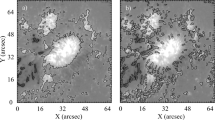Abstract
An examination of the tilt angles of multi-spot sunspot groups and plages shows that on average they tend to rotate toward the average tilt angle in each hemisphere. This average tilt angle is about twice as large for plages as it is for sunspot groups. The larger the deviation from the average tilt angle, the larger, on average, is the rotation of the magnetic axis in the direction of the average tilt angle. The rate of rotation of the magnetic axis is about twice as fast for sunspot groups as it is for plages. Growing plages and spot groups rotate their axes significantly faster than do decaying plages and spot groups. There is a latitude dependence of this effect that follows Joy's law. The fact that these tilt angles move toward the average tilt angle and not toward 0 deg (the east-west orientation), combined with other results presented here, suggest that a commonly accepted view of the origin of active region magnetic flux at the solar surface may have to be re-examined.
Similar content being viewed by others
References
Babcock, H. W.: 1961, Astrophys. J. 133, 572.
Choudhuri, A. R.: 1989, Solar Phys. 123, 239.
Choudhuri, A. R.: 1990, Astrophys. J. 355, 733.
Choudhuri, A. R. and Gilman, P. A.: 1987, Astrophys. J. 316, 800.
Choudhuri, A. R. and D'Silva, S.: 1990, Astron. Astrophys. 239, 34.
DeLuca, E. E. and Gilman, P. A.: 1986, Geophys. Astrophys. Fluid Dynamics 37, 85.
DeLuca, E. E. and Gilman, P. A.: 1991, in A. N. Cox, W. C. Livingston, and M. S. Matthews (eds.), Solar Interior and Atmosphere, University of Arizona Press, Boulder, p. 275.
D'Silva, S.: 1993, Astrophys. J. 407, 385.
D'Silva, S. and Choudhuri, A. R.: 1991, Solar Phys. 136, 201.
D'Silva, S. and Choudhuri, A. R.: 1993, Astron. Astrophys. 272, 33.
D'Silva, S. and Howard, R. F.: 1993, Solar Phys. 148, 1.
Fan, Y., Fisher, G. H., and DeLuca, E. E.: 1993, Astrophys. J. 405, 390.
Fan, T., Fisher, G. H., and McClymont, A. N.: 1994, Astrophys. J. 436, 907.
Fisher, G. H., Fan, Y., and Howard, R. F.: 1995, Astrophys. J. 438, 463.
Golub, L., Davis, J. M., Vaiana, G. S., and Weiss, N. O.: 1981, Astrophys. J. 243, 309.
Hale, G. E., Ellerman, F., Nicholson, S. B., and Joy, A. H.: 1919, Astrophys. J. 49, 153.
Harvey, K. L.: 1993a, ‘Magnetic Bipoles on the Sun’, Thesis Utrecht University, Chapter 3.
Harvey, K. L.: 1993b Solar Phys. 148, 85.
Harvey, K. L.: 1996, Solar Phys., in press.
Howard, R. F.: 1989, Solar Phys. 123, 271.
Howard, R. F.: 1991a, Solar Phys. 132, 257.
Howard, R. F.: 1991b, Solar Phys. 136, 251.
Howard, R. F.: 1991c, Solar Phys. 132, 49.
Howard, R. F.: 1991d, Solar Phys. 135, 43.
Howard, R. F.: 1991e, Solar Phys. 135, 327.
Howard, R. F.: 1991f, Solar Phys. 134, 233.
Howard, R. F.: 1992, Solar Phys. 137, 205.
Howard, R. F.: 1994, Solar Phys. 149, 23.
Howard, R. F.: 1996, Ann. Rev. Astron. Astrophys. 34, in press.
Howard, R., Gilman, P. A., and Gilman, P. I.: 1984, Astrophys. J. 283, 373.
Moreno-Insertis, F.: 1992, in J. H. Thomas and N. O. Weiss (eds.), Sunspots, Theory and Observations, Kluwer Academic Publishers, Dordrecht, Holland, p. 385.
Moreno-Insertis, F.: 1994, in M. Schüssler and W. Schmidt (eds.), Solar Magnetic Fields, Cambridge University Press, Cambridge, p. 117.
Parker, E. N.: 1955, Astrophys. J. 121, 491.
Rosner, R.: 1980, in A. K. Dupree (ed.), Cool Stars, Stellar Systems, and the Sun, Smithsonian Astrophys. Obs. Report, No. 389, p. 79.
Schmitt, J. H. M. M. and Rosner, R.: 1983, Astrophys. J. 265, 901.
Schüssler, M.: 1993, in F. Krause, K.-H. Rädler, G. Rüdiger (eds.), ‘The Cosmic Dynamo’, IAU Symp. 157, 27.
Schüssler, M., Caligari, P., Ferriz-Mas, A., and Moreno-Insertis, F.: 1994, Astron. Astrophys. 281, L69.
Spiegel, E. A. and Weiss, N. O.: 1980, Nature 287, 616.
van Ballegooiien, A. A.: 1982, Astron. Astrophys. 113, 99.
Wang, Y.-M. and Sheeley, N. R., Jr.: 1991, Astrophys. J. 375, 761.
Zwaan, C.: 1992, in J. H. Thomas and N. O. Weiss (eds.), Sunspots: Theory and Observations, Kluwer Academic Publishers, Dordrecht, Holland, p. 75.
Author information
Authors and Affiliations
Additional information
Operated by the Association of Universities for Research in Astronomy, Inc., under Cooperative Agreement with the National Science Foundation.
Rights and permissions
About this article
Cite this article
Howard, R.F. Tilt-angle variations of active regions. Sol Phys 167, 95–113 (1996). https://doi.org/10.1007/BF00146330
Received:
Revised:
Issue Date:
DOI: https://doi.org/10.1007/BF00146330




